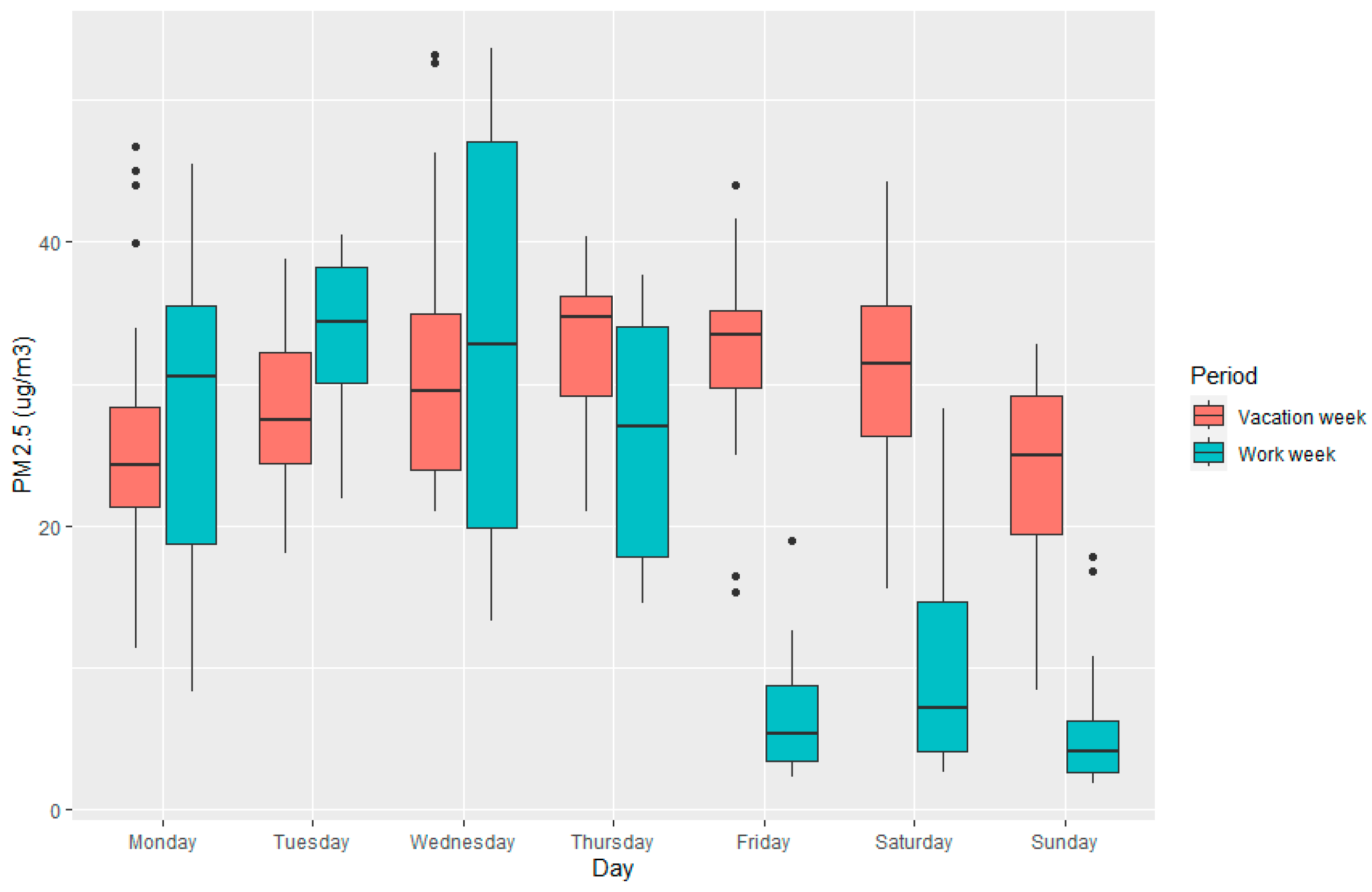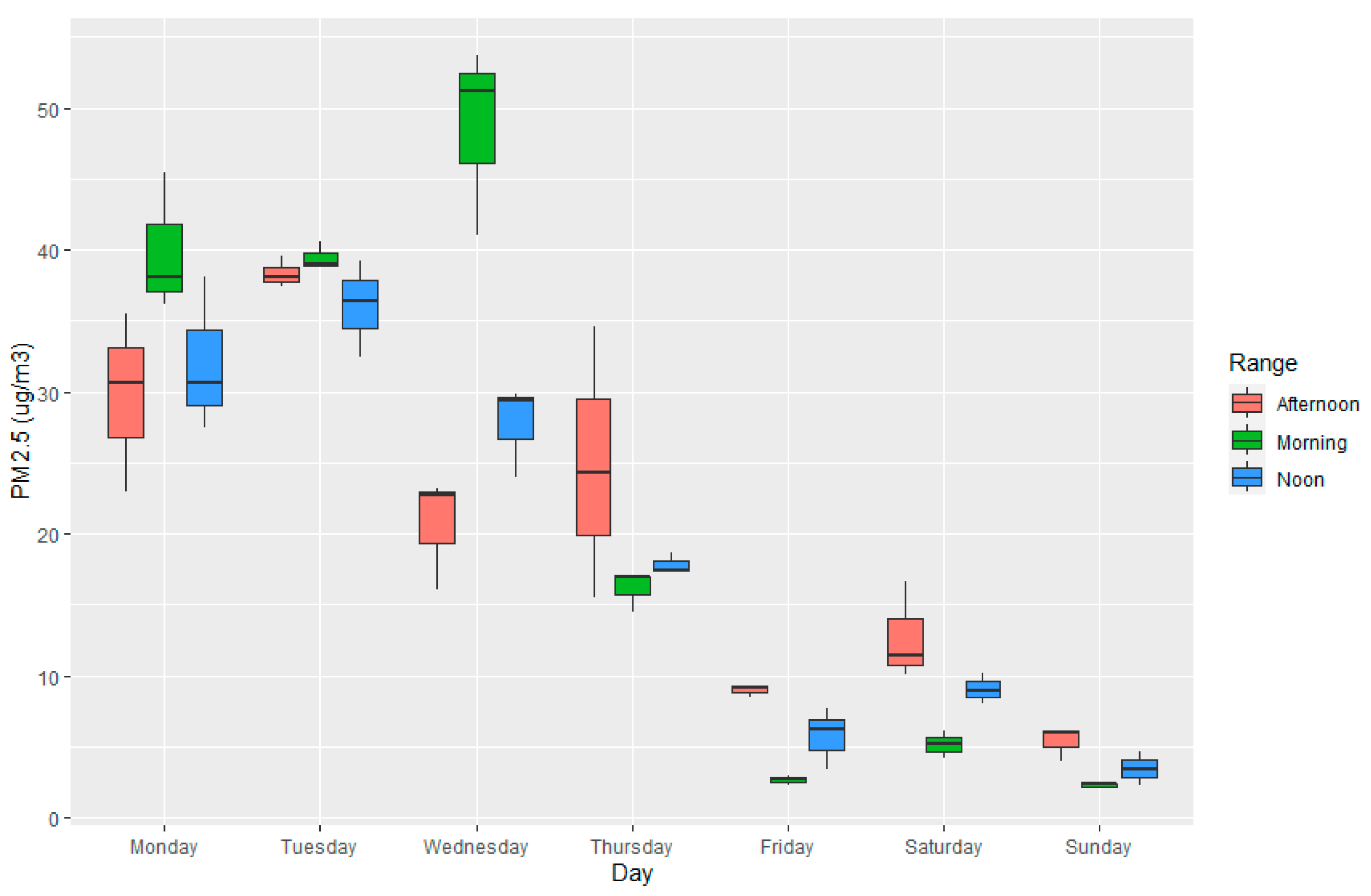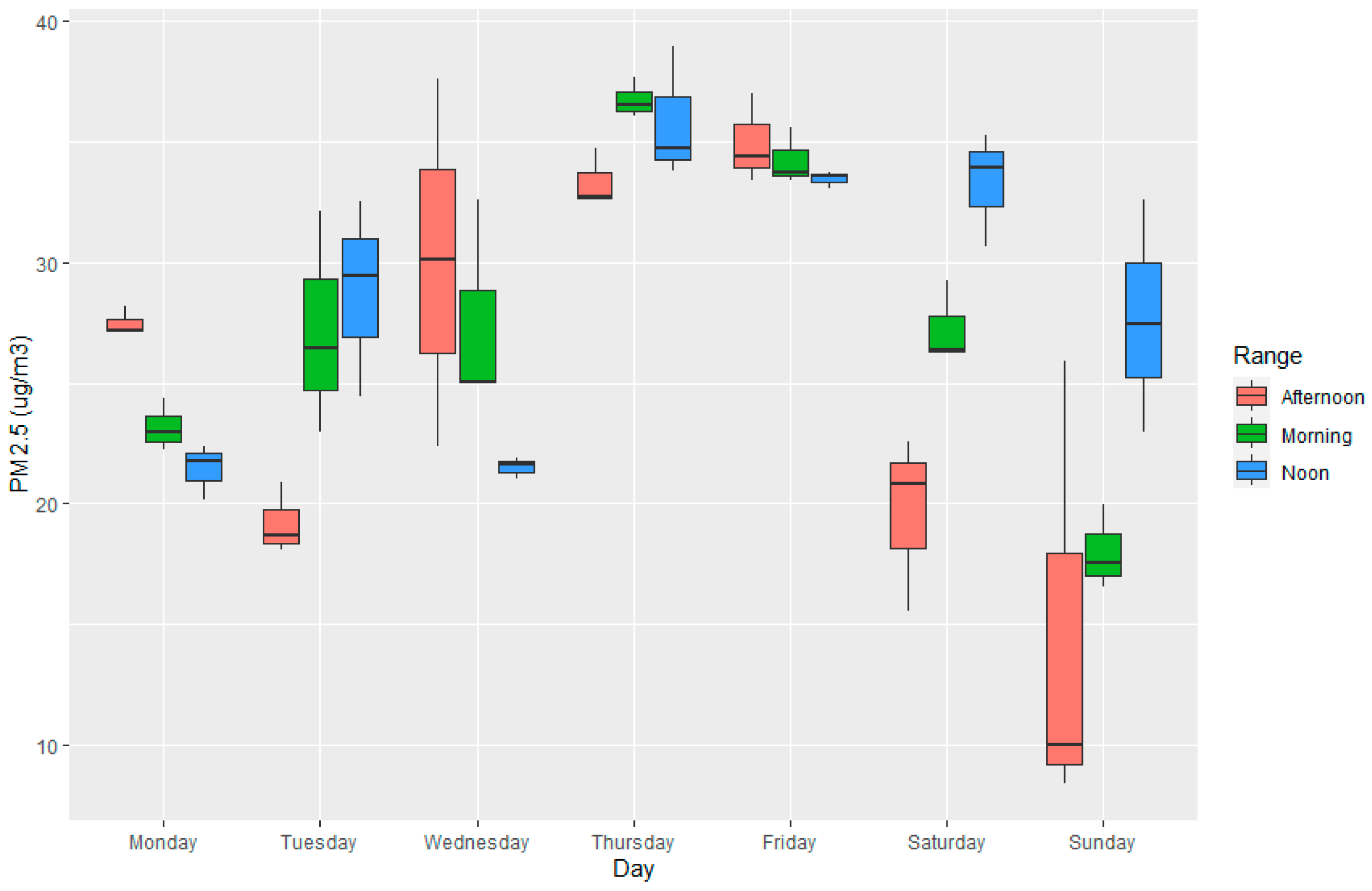Association between Ambient Air Pollution by Particulate Matter (PM2.5) and Vehicular Traffic in Downtown Port City of Tampico, Mexico †
Abstract
:1. Introduction
2. Materials and Methods
2.1. Area of Study
2.2. Data Collection and Analysis
3. Results and Discussion
3.1. Descriptive Analysis
3.2. Correlation Analysis
4. Conclusions
Author Contributions
Funding
Institutional Review Board Statement
Informed Consent Statement
Data Availability Statement
Acknowledgments
Conflicts of Interest
References
- Asha, P.; Natrayan, L.; Geetha, B.T.; Rene, J.; Sumathy, B.R.; Varalakshmi, G.; Neelakandan, S. IoT enabled environmental toxicology for air pollution monitoring using AI techniques. Environ. Res. 2022, 205, 112574. [Google Scholar] [CrossRef] [PubMed]
- Huang, Y.; Surawski, N.C.; Yam, Y.; Lee, C.K.C.; Zhou, J.L.; Organ, B.; Chan, E.F.C. Re-evaluating effectiveness of vehicle emission control programmers targeting high-emitters. Nat. Sustain. 2020, 3, 904–907. [Google Scholar] [CrossRef]
- Wang, Q.; Feng, H.; Feng, H.; Yu, Y.; Li, J.; Ning, E. The impacts of road traffic on urban air quality in Jinan based GWR and remote sensing. Sci. Rep. 2021, 11, 15512. [Google Scholar] [CrossRef] [PubMed]
- Manisalidis, I.; Stavropoulou, E.; Stavropoulos, A.; Bezirtzoglou, E. Environmental and health impacts of air pollution: A review. Public Health 2020, 8, 14. [Google Scholar] [CrossRef] [PubMed]
- Préndez, M.; Araya, M.; Criollo, C.; Egas, C.; Farías, I.; Fuentealba, R.; González, E.; Henríquez, C.; Romero, H. Urban Trees and Their Relationship with Air Pollution by Particulate Matter and Ozone in Santiago, Chile. Urban Clim. Lat. Am. 2019, 167–206. [Google Scholar] [CrossRef]
- Wong, Y.K.; Huang, X.H.H.; Cheng, Y.Y.; Peter, L.K.K.; Yu, A.L.C.; Tangm, W.Y.; Chan, D.H.L.; Zhen, J.Y. Estimating contributions of vehicular emissions to PM2.5 in a roadsite environment: A multiple approach study. Sci. Total Environ. 2019, 672, 776–788. [Google Scholar] [CrossRef] [PubMed]
- Farwick, H.F.H.; Marcel, M.; Tomasz, G.; Tim, H.; Marc, R.; Jaroslaw, G.; Rainer, V.; Thorsten, B. On-road vehicle measurements of brake wear particle emissions. Atmos. Environ. 2019, 217, 116943. [Google Scholar] [CrossRef]
- Mamakos, A.; Arndt, M.; Hesse, D.; Augsburg, K. Physical Characterization of Brake Wear Particles in a PM10 Dilution Tunnel. Atmosphere 2019, 10, 639. [Google Scholar] [CrossRef]
- De Keijzer, C.; Agis, D.; Ambrós, A.; Arévalo, G.; Baldasano, J.M.; Bande, S.; Barrera-Gómez, J.; Benach, J.; Cirach, M.; Dadvand, P.; et al. The association of air pollution and greenness with mortality and life expectancy in Spain: A small-area study. Environ. Int. 2017, 99, 170–179. [Google Scholar] [CrossRef] [PubMed]
- Gireesh, P.K.; Lekhana, P.; Tejaswi, M.; Chandrakala, S. Effects of vehicular emissions on the urban environment—A state of the art. Mater. Today Proc. 2021, 45, 6314–6320. [Google Scholar] [CrossRef]
- Diario Oficial de la Federación (DOF). Salud Ambiental. Criterio para Evaluar la Calidad del Aire Ambiente, con Respecto a las Partículas Suspendidas PM10 y PM2.5. Valores Normados para la Concentración de Partículas Suspendidas PM10 y PM2.5 en el aire Ambiente, Como Medidas de Protección a la Salud de la Población. NOM-025-SSA1-2021. 2021. Available online: https://www.gob.mx/salud/documentos/norma-oficial-mexicana-nom-025-ssa2-2014-secretariado-tecnico-del-consejo-nacional-de-salud-mental (accessed on 27 June 2023).
- Secretaría General del Gobierno del Estado de Tamaulipas (Segob-Tam). Programa Municipal de Ordenamiento Territorial y Desarrollo Urbano del Municipio de Tampico. Available online: http://www.imeplansurdetamaulipas.gob.mx/proyectos/pot-tampico/ (accessed on 24 May 2023).
- Secretaría de Desarrollo Agrario, Territorial y Urbano (SEDATU). Zonas Metropolitanas SUN. 2018. Available online: https://dof.gob.mx/nota_detalle_popup.php?codigo=5551585 (accessed on 27 June 2023).
- Instituto Nacional de Estadística y Geografía (INEGI). Parque Vehicular. Tampico, Tamaulipas. 2020. Available online: https://www.inegi.org.mx/app/buscador/default.html?q=parque+vehicular+tampico#tabMCcollapse-Indicadores (accessed on 24 April 2023).
- Secretaría de Comunicaciones y Transportes. Manual para Obtener los Volúmenes de Tránsito en Carreteras. SCT. 2016. Available online: https://www.sct.gob.mx/fileadmin/DireccionesGrales/DGST/Manuales/manual_volumen_de_transito/Manual_volumenes__2016_v2.pdf (accessed on 24 May 2023).
- Hua, J.; Zhang, Y.; de Foy, B.; Xiaodong, M.; Jing, S.; Chuan, F. Competing PM2.5 and NO2 holiday effects in the Beijing area vary locally due to differences in residential coal burning and traffic patterns. Sci. Total Environ. 2021, 750, 141575. [Google Scholar] [CrossRef] [PubMed]
- Zhao, S.; Tian, H.; Luo, L.; Liu, H.; Wu, B.; Liu, S.; Bai, X.; Xiangyang, B.; Wei, L.; Liu, X.; et al. Temporal variation characteristics and source apportionment of metal elements in PM2.5 in urban Beijing during 2018–2019. Environ. Pollut. 2021, 268, 115856. [Google Scholar] [CrossRef] [PubMed]
- He, K.; Wang, Y.; Su, W.; Yang, H.A. Varying-coefficient regression approach to modeling the effects of wind speed on the dispersion of pollutants. Environ. Ecol. Stat. 2022, 29, 433–452. [Google Scholar] [CrossRef]
- Beleño, M.L.; Colegial, G.; Juan, D.; Barrera, P.; Martha, L. Correlación entre el flujo vehicular, el PM2.5 y variables meteorológicas, un estudio de caso al oriente de Bucaramanga (Colombia). Bistua Rev. De La Fac. De Cienc. Básicas 2020, 18, 15–25. [Google Scholar] [CrossRef]



| Monday | Tuesday | Wednesday | Thursday | Friday | Saturday | Sunday | |
|---|---|---|---|---|---|---|---|
| Q1 | 0.486 | −0.437 | −0.943 ** | −0.257 | −0.895 ** | 0.290 | 0.771 |
| Q2 | 0.543 | 0.648 | 0.829 * | −0.371 | −0.828 * | −0.914 * | −0.371 |
| Q3 | −0.543 | −0.561 | 0.029 | 0.371 | 0.960 ** | 0.838 * | 0.371 |
| Monday | Tuesday | Wednesday | Thursday | Friday | Saturday | Sunday | |
|---|---|---|---|---|---|---|---|
| Q1 | 0.331 | −0.796 * | −0.657 | −0.504 | −0.551 | 0.261 | −0.257 |
| Q2 | −0.591 | −0.107 | 0.600 | 0.631 | 0.857 * | 0.486 | 0.314 |
| Q3 | 0.444 | −0.097 | −0.257 | 0.454 | −0.442 | −0.486 | 0.257 |
Disclaimer/Publisher’s Note: The statements, opinions and data contained in all publications are solely those of the individual author(s) and contributor(s) and not of MDPI and/or the editor(s). MDPI and/or the editor(s) disclaim responsibility for any injury to people or property resulting from any ideas, methods, instructions or products referred to in the content. |
© 2023 by the authors. Licensee MDPI, Basel, Switzerland. This article is an open access article distributed under the terms and conditions of the Creative Commons Attribution (CC BY) license (https://creativecommons.org/licenses/by/4.0/).
Share and Cite
Nava-Velez, M.E.; Macías-Hernández, B.A.; Tello-Leal, E.; Ventura-Houle, R. Association between Ambient Air Pollution by Particulate Matter (PM2.5) and Vehicular Traffic in Downtown Port City of Tampico, Mexico. Environ. Sci. Proc. 2023, 27, 32. https://doi.org/10.3390/ecas2023-16348
Nava-Velez ME, Macías-Hernández BA, Tello-Leal E, Ventura-Houle R. Association between Ambient Air Pollution by Particulate Matter (PM2.5) and Vehicular Traffic in Downtown Port City of Tampico, Mexico. Environmental Sciences Proceedings. 2023; 27(1):32. https://doi.org/10.3390/ecas2023-16348
Chicago/Turabian StyleNava-Velez, Mariela Estefania, Bárbara A. Macías-Hernández, Edgar Tello-Leal, and René Ventura-Houle. 2023. "Association between Ambient Air Pollution by Particulate Matter (PM2.5) and Vehicular Traffic in Downtown Port City of Tampico, Mexico" Environmental Sciences Proceedings 27, no. 1: 32. https://doi.org/10.3390/ecas2023-16348
APA StyleNava-Velez, M. E., Macías-Hernández, B. A., Tello-Leal, E., & Ventura-Houle, R. (2023). Association between Ambient Air Pollution by Particulate Matter (PM2.5) and Vehicular Traffic in Downtown Port City of Tampico, Mexico. Environmental Sciences Proceedings, 27(1), 32. https://doi.org/10.3390/ecas2023-16348






